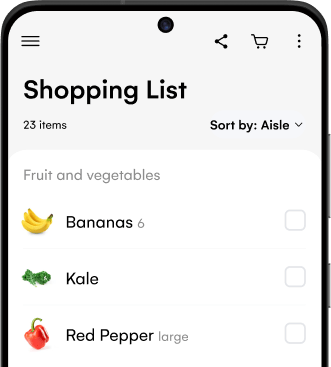Estimated reading time: 9 minutes
Food is one of the foundations of good health. Along with good genes, physical activity, sleep, and other healthy habits, it can be the difference between healthy and unhealthy. But you don’t have to stick to a diet made up solely of lettuce, especially if you consider implementing the 80/20 rule in one way or another.
Eating healthy foods 100% of the time can be challenging. You’ll probably miss some foods that aren’t the most nutritious options but taste good. You might find it hard to prepare healthy meals all the time when you’re tired, busy, or stressed. Sometimes you might not want to order the salad when you’re out for a meal with friends who are all enjoying nachos or burgers. Or you may find yourself craving certain foods even though you know they aren’t the healthiest.
Plan meals together! Share this plan with your family

That’s where the 80/20 rule of healthy eating can help. This approach to food considers all food to be on the table. As long as you eat healthy and nutritious food 80% of the time, you can eat treats, sweets, and other less healthy food 20% of the time. Sounds pretty doable, right?
Here’s what you need to know about this rule and how you may apply it to your meal plans.
What is the idea behind the 80/20 rule of healthy eating?
Teresa Cutter, an Australian chef, popularized the 80/20 rule of healthy eating. She encouraged people to eat healthy foods most of the time and eat treats less often while still allowing yourself the freedom to indulge in foods you love, even if they aren’t packed with vitamins and fiber.
This eating style has also been called the weekend diet. But whatever you call it, the principles are the same: eating healthy food more than unhealthy, and in a 4:1 ratio.

How can you adopt the 80/20 diet?
To adopt the 80/20 diet, you need to know the foods considered healthy (80%) and those considered treats (20%). After that, it’s mostly a question of deciding when and where to indulge in your 20% and finding healthy foods you love for the 80% too.
The healthy foods (80%)
Healthy foods are typically those that provide lots of nutrients and benefits to your body including vitamins, minerals, and phytochemicals (compounds that help your body fight disease).
Examples of healthy foods include:
- Vegetables: cucumber, eggplant, carrots, tomatoes, broccoli, cabbage, lettuce, onions, and leeks.
- Fruits: oranges, bananas, pineapples, grapes, apples, mangoes, papaya, dates, grapes, peaches, apricots, pomegranates, and pears.
- Lean protein: fish, poultry, eggs.
- Whole grain: oats, wheat, brown rice, bulgur, quinoa, maize.
- Healthy fats: olive oil, avocado.
That doesn’t mean you can only eat salads or that every meal needs to have broccoli. It simply means you want to get a good variety of fruits and vegetables, prioritise lean protein, and limit your refined carbs.
There are loads of recipes which fit the bill here, from things like baked salmon and brown rice through to roasted chicken and salad or even shakshuka.
The occasional foods (20%)
The occasional foods don’t provide many nutrients but taste nice. They are typically high in calories and low in nutrients. They are often processed or highly processed foods and contain high amounts of
- Sugar
- Salt
- Unsaturated fat
- Trans fat
- White flour
Examples of such foods are:
- Sweets: candy, jams, pudding, and most desserts.
- Pastry: cakes, white bread, pizza, pies, and other pastries.
- Red meat: Beef, goat meat, buffalo, and pork.
- Processed meat: bacon, sausages, hot dog, deli meats, pepperoni, ham, and beef jerky.
However, they can still have a place in your diet. While some foods fuel our bodies, others fuel our souls – and we also know that food plays a central role in plenty of celebrations, occasions, and social events. Knowing that you have wiggle room to order the dessert, eat your favourite takeout with your partner, or have a hot dog at a kids’ party can help bring balance and ensure you don’t feel deprived.

How can you follow the 80/20 rule of healthy eating
You can apply the 80/20 rule of healthy eating in many ways depending on your lifestyle and goals. Here are some ideas to consider.
Weekend treats or a weekly approach
The 80/20 rule has also been called the 80/20 diet or the Weekend Diet. One way to follow it is to eat healthy throughout the week and eat treats or occasional meals during the weekend.
You could also reserve 20% of your weekly meals for treats. For instance, if you eat three meals a day and 21 a week, you could use that as a basis. Each week you would make 17 out of 21 meals based on healthy foods, and allow the remaining 4 to be less nutritious.
This approach makes it easy to remember when to eat healthily and when to have treats. You could prepare healthy meals for the week and take some treats during the weekend. And if you are using the weekly approach, it’s easy to schedule four treats during the week.
Daily choices
Another approach is eating healthy foods four out of five times every day.
You could make 80% of your meals healthy and 20% from the occasional group.
This approach could make choosing healthy foods more natural. And make it less likely for you to overeat foods from the occasional category.
A meal-based approach
Another way to apply this rule is to have meals where 80% of each meal is from the healthy category. For example, you could have vegetables and lean protein for 80% of the meal and finish off with cake or refined carbs for the other 20%.
Snacking
Snacking has a bad reputation, but it can help you meet your daily requirements for certain vitamins and minerals.
You can apply the 80/20 of healthy eating to snacks too. By selecting healthy foods as snacks 80% of the time and enjoying foods from the occasional group 20% of the time, you still meet the requirements.
Create your own recipes from scratch

Pros and cons of the 80/20 healthy eating rule
The 80/20 healthy eating rule has merits and demerits. Consider them before you decide if this is the right approach for you.
Pros
There are several pros to this approach to food. Some of them include the following:
- Easy: This is a straightforward approach to healthy eating. You don’t need to calculate anything. Nothing is off-limits; you can do this without reading ingredient lists or weighing foods with a kitchen scale.
- Fun: Your favorite treats are still allowed. This makes it more fun to follow. You can have candy, cake, and even chocolate. And you are less likely to feel deprived or starved. You can still eat foods that aren’t too nutritious as long as they are in the 20%.
- Sustainable: You can eat anything with this plan, so it’s easy to stick to it for the long term.
- Inclusive: You can adopt this approach even if you have dietary restrictions. You can still use this approach even if you are vegan, gluten-free, living with diabetes, on a low-salt diet, or have allergies.
- Flexible: You can adopt this approach to eating to most lifestyles. There are no rigid requirements, and nothing is off-limits.
- Builds healthy habits: This diet is based almost entirely on your choices. Eating this way encourages you to choose healthy foods and learn ways to prepare them. This more sustainable approach makes healthy eating a normal part of life.
- An expert-approved approach: This diet encourages you to eat vegetables, fruits, whole grains, and lean proteins liberally. This approach to food is similar to diets like the Mediterranean diet that experts have praised.

Cons
Despite those glowing benefits, the 80/20 rule may only work for some people. Here are some limitations of this approach.
- Unstructured: This diet only provides a little guidance. That means it’s easy to overeat or undereat. It also means that if you have strict dietary goals, you might not meet them. For example, this diet may not give the best results if you want to lose weight.
- Unfocused: Although this diet is for healthy eating, it doesn’t focus on any particular goals, and it’s hard to know if you are doing it right. Healthy eating is a broad term and what you consider healthy foods might not be what others do.
- May be pricey and time-consuming: The foods in the occasional category are often cheaper and easier to get than healthy foods. Healthy foods may require additional money and time for preparation.
- May backfire: By allowing all foods, including those linked to health risks and low in nutrients, this diet may unwittingly encourage people to eat more of the foods they would rather avoid.
Who should follow the 80/20 rule of healthy eating?
Most people can follow the 80/20 rule of healthy eating. It can be a great way to approach food if you want a plan with no calculations or deprivation.
But if you have specific goals you need to achieve or health conditions, you may need to discuss this with a dietician or healthcare provider.
The 80/20 rule of healthy eating encourages you to choose healthy foods most of the time. It emphasizes fresh, nutritious food in your diet while allowing less nutritious foods too. It’s a fun, easy, inclusive approach to eating that almost anyone can adopt.
However, if you have strict goals or any health conditions, it may not yield the best results. Consulting your healthcare provider or a registered dietitian is a good idea when in doubt.



